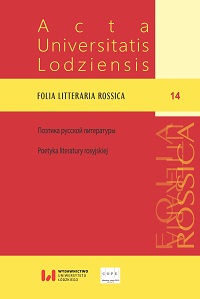Photopoetics as Structure: ‘A Camera is a Scary Thing…’ by Boris Khersonsky
DOI:
https://doi.org/10.18778/1427-9681.14.15Keywords:
the visual in literature, photography in literature, photography in lyric poetry, photopoeticsAbstract
The article is dedicated to the analysis of the poem “fotokamera strashnaya veshch…” [‘a camera is a scary thing...’] by Boris Khersonsky. The analysis is divided into three levels encompassing the sound, vocabulary and grammar, and the plot. The structural features of the poem are identified and it is shown that they conform to the peculiarities of photopoetics, such as transgressiveness, discreteness, isolation, documentary character and metonymic treatment of the object. The sound-level analysis reveals a lack of order, in view of which rhyme becomes the ordering mechanism of the poem. Syntagms corresponding to the syllabotonic meter are broken by enjambements, some of which also violate stanza boundaries. The density of consonants and vowels and the rhythmic scheme allow the author of the paper to highlight the weak and strong points of the poem, as well as the principles of the relations between stanzas: they can form crosswise or regular pairs, both opposed and conjoined. The poem’s vocabulary features two thematic fields, one relating to the camera, the other to the soul. The camera is mostly connected with death and immobility, it can capture only scattered fragments, while the soul, on the contrary, is living, moving, it can see and contains memories. Combining the two groups in metaphors and personifications can be perceived as an attempt to overcome antinomies and at the same time as acknowledging that it is impossible to do so. The initial situation is that of the horror of the camera. Mechanically organised memory (photo album) is lost, and the human soul proves to be more capacious and more perfect, which helps to negate and thus ultimately overcome the initial situation. The lyrical subject cannot appear in the text, and where he strives to do this, he turns out to be helpless, the weakest link in the plot. In the first stanza, the world captured by the camera falls apart and becomes insignificant – it loses its uniqueness due to the infinity of automatic clicks (the camera is alive). The second attempt to collect this world within the framework of the album proves futile (the soul is dead). In the third stanza, the situation is reversed (the soul is alive). The poem ends, in essence, with the death of the camera, because its gaze lacks viability. The turning point in which the subject becomes aware of himself in the process of reflection is the moment of differentiation between his vision and the vision of the camera: it does not see, but the lyrical subject does. Thus, photography, which appears to the reader primarily as a topic, becomes the basis of the poetics of the entire text. Throughout the poem, we are faced with how, for example, metric-rhythmic and syntactic discreteness is overcome with the help of stanzaic unity, how fragmentation of imagery turns into integrity through oxymoronic combinations; grammatical isolation and limitations of vocabulary are not absolute; the transgression of the lyrical subject, forcing him into losing his identity, is overcome by gaining his own vision. Finally, object metonymy – replacing memories with photographs – ends with the defeat of the camera and the triumph of the integrity of the subject.
Downloads
References
Khersonskii, Boris G. Mramornyi list: italianskie stikhi. Moskva: ARGO-RISK: Knizhnoe obozrenie, 2009 http://www.vavilon.ru/texts/khersonsky2.html
Google Scholar
Lavlinskii, Sergei P., Gurovich, Nadezhda M. Vizualnoe v literature. In: Poetika: slovar aktualnykh terminov i ponyatii, ed. N. D. Tamarchenko. Moskva: Izdatelstvo Kulaginoi: Intrada, 2008: 37–39.
Google Scholar
Lishaev, Sergei A. “Pomnit fotografiei (k analizu fotograficheskoi konstruktsii pamiati)”. Vestnik Samarskoi gumanitarnoi akademii. Seriia ‘Filosofiya. Filologiya’. No. 1(5) (2009): 12–36.
Google Scholar
Lyapin, Sergei E. “’Segmentnyi’ dolnik: k opisaniyu metricheskikh novatsii Iosifa Brodskogo”. Vestnik Moskovskogo universiteta. Ser. 9, Filologiya. No. 6 (2011): 36–46.
Google Scholar
Malkina, Viktoriya Ya. “Sobytie i siuzhet v liricheskom stikhotvorenii (‘Nebyvalaya osen postroila kupol vysokii…’ A. Akhmatovoi)”. Novyi filologicheskii vestnik. No. 3(22) (2012): 18–22.
Google Scholar
Samarkina, Mariya D. “Fotograficheskoe v tsikle romanov o Garri Pottere”, Articult. No. 24(4) (2016): 67–72.
Google Scholar












